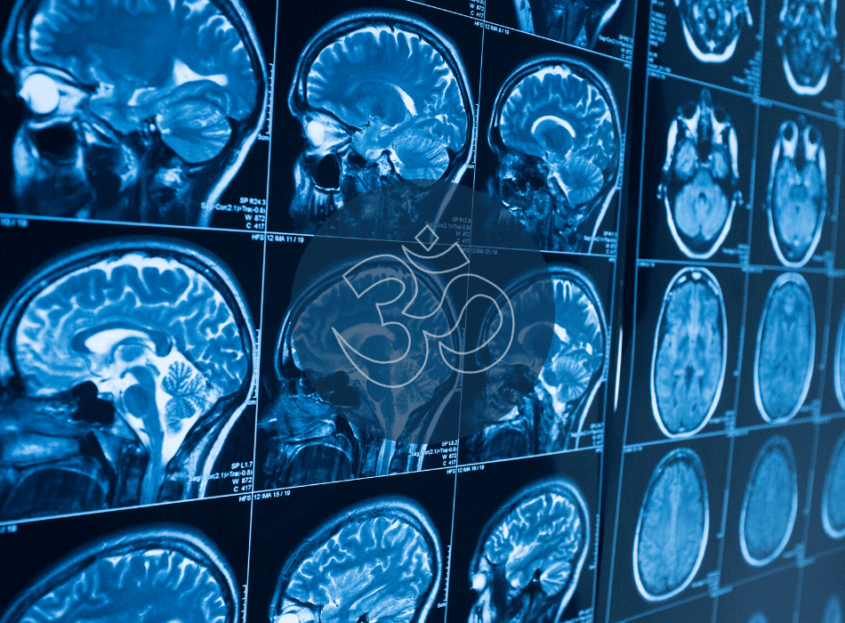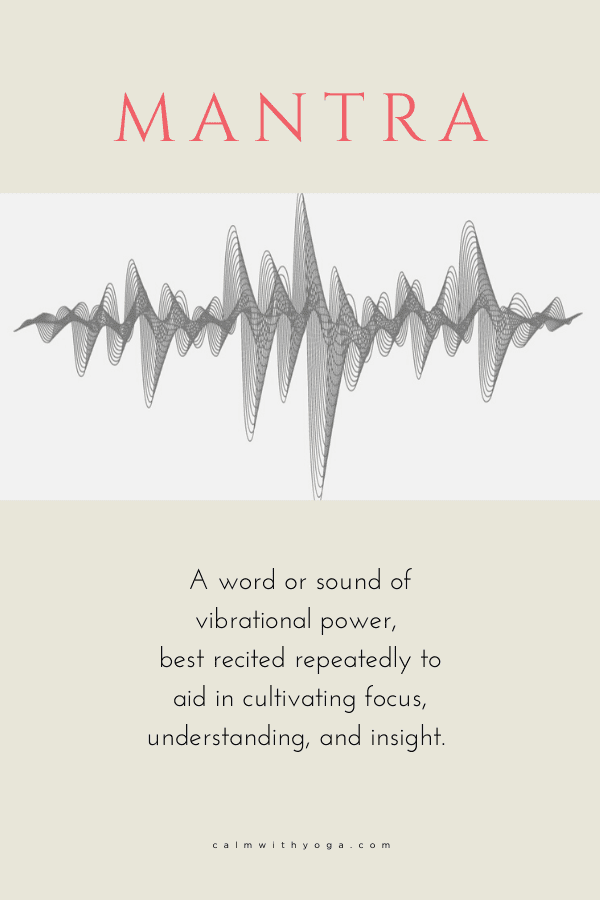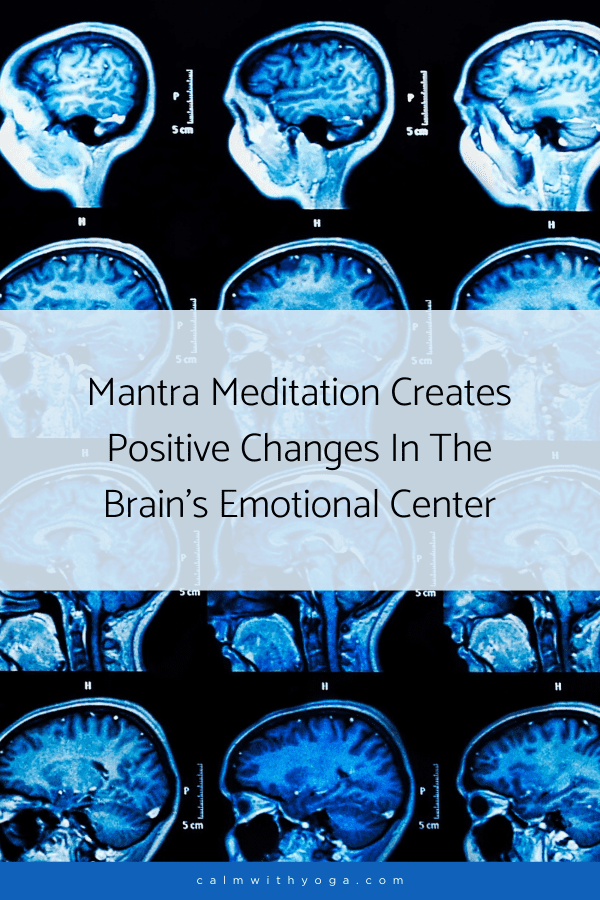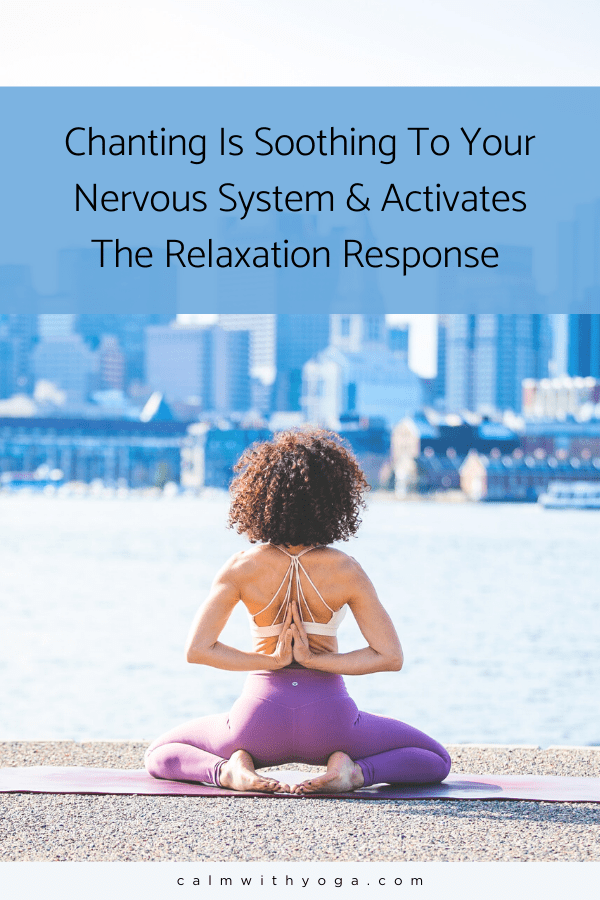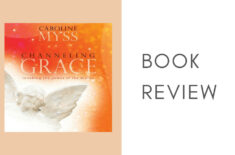“Chanting is a way of getting in touch with yourself.
It’s an opening of the heart and letting go of the mind and thoughts.
It deepens the channel of grace, and it’s a way of being present in the moment.”
– Krishna Das, Vocalist & artist of Yogic devotional music known as Kirtan
You’ve probably already had a taste of mantra meditation if you’ve gone to a yoga class where they tune in by chanting either Om (Aum) or the Adi Mantra right at the beginning.
It’s common to feel awkward about chanting when you’re first starting out on the yoga journey.
It’s not something we’re commonly taught here in the West, but in eastern traditions like yoga, traditional Chinese medicine (Qigong), and Buddhism chanting meditation is a common way to cultivate a quiet mind, well-being, and inner peace.
Ancient yogis and even the Buddha himself taught that mantra chanting is a way to prepare the mind for meditation.
In yoga, Sanskrit mantras are used as a way to practice Bhakti Yoga – the yoga of love and devotion.
When these devotional mantras are part of a group practice setting the gathering is referred to as kirtan.
Catholicism also has had its own version of this devotional practice throughout history – Gregorian chants were recited in Latin as a ritualistic part of a mass and religious prayer.
So if global ancient wisdom has regarded mantra meditation as an effective tool for self-regulation and the cultivation of mindfulness and personal power what can it offer us today in our hyper-active and fast-paced modern world?
What do medical studies reveal about the healing power of chanting?
What has neuroscience discovered after scanning numerous brains of meditators and chanters?
The Real Meaning of ‘Om (Aum)’ In Yoga:
“Aum is a word that represents to our ears the sound of the energy of the universe of which all things are manifestations.
Aum – starts in the back of the mouth – Aaaaahhhh.
And then you fill the mouth – Uuuuuuhhh.
And Mmmmmhhh closes at the mouth.
When you pronounce this properly, all vowel sounds are in that pronunciation – aaauumm.
Consonants are regarded as interruptions of aum.
All words are thus fragments of aum.
Aum is a symbolic sound that puts you in touch with that throbbing being that is the universe.
It’s the zoom of being in the world.
To be in touch with that, and get a sense of that is the biggest experience of all.”
– Joseph Campbell, Mythologist, Scholar, & Author of ‘The Hero With a Thousand Faces’
According to ancient Vedic and yogic texts, Om is the primordial sound of creation.
To vocalize it is to merge with the infinite intelligence and creative wisdom of the Universe.
If the meaning of Yoga is to unite and connect, then Om is the vehicle through which we can unite with the Supreme Consciousness, Source, and Spirit.
1- Mantra Meditation of Om can help us reach the highest states of Yogic practice.
According to the Yoga Sutras of Patanjali, a 1,700-year-old authoritative text on how to walk and live the 8-Limbed Yogic Path, one can experience the ultimate goal of Yoga, Samadhi (deep inner knowing, self-realization, transcendence, and profound bliss) through chanting meditation.
“Cessation of thought and Samadhi is attained by devotion with total dedication to Ishvara.”
– Yoga Sutra 1.23
It’s by observing and practicing the yogic principle of Ishvara Pranidhana (surrender, dedication, and devotion to a higher power) that we can come to know ourselves more deeply:
“From this practice all the obstacles disappear and simultaneously dawns knowledge of the Inner Self.”
– Yoga Sutra 1.29
Ishvara is:
- An all-knowing higher power
- The infinite intelligence and creative wisdom of the Universe
- A universal consciousness, source, and spirit
“Before thought can cease entirely, the practitioner must withdraw from the phenomenal world and turn inward, attaining introspection.
A host of distractions, however, both mental and physical may arise to prevent inner calm.
Chanting the resonant syllable Aum clears away obstacles and focuses the mind…”
– Barbara Stoler Miller, author of “Yoga: Discipline of Freedom”
Through Yoga, we learn to unite our human consciousness and personality with universal consciousness.
Merging with Ishvara helps us heal painful memories, unresolved traumatic events, and imbalanced perceptions that keep us stuck in lower levels of thinking and being.
It helps us strengthen our physical bodies, boost immunity, reduce inflammation, and increase the flow of vital energy (prana) through every cell, organ, and tissue.
When we ascend up the different stages or limbs of Yoga we begin to feel more compassionate towards ourselves and others, we become more intuitive, grateful, creative, and inspired.
2- We can unite with our true essence and high self through the repetition of Om.
In Yoga Sutra 1.27-28 it says:
“The word expressive of Ishvara is the mystic sound Om.
Repetition of this syllable reveals its meaning.”
Here the Yogi is introduced to the practice of Japa Yoga.
Japa is the repetition of a mantra.
A mantra is a sound or syllable with vibrational power.
Om is considered the “mantra of all mantras” and so is called the main Seed Mantra or “Bija Mantra.”
Japa Yoga is the communion of your human self (personality) with your spirit and Ishvara through the repetition of a mantra.
3- Repetition of Om can help to increase our vital energy levels (prana)

“Prana is the basic vibration that always exists.
It is neverending.
… the basic sound (Om) is always vibrating in you.
It is the seed from which all other sounds manifest…
(Om) has the power to create everything.”
– Swami Satchidananda, The Yoga Sutras of Patanjali
Japa practice of a mantra creates a vibrational hum in between repetitions.
“Aum…. Aum… Aum…”
The space in between aums (oms) vibrates with prana (vital energy).
By engaging in mantra meditation we’re also increasing the flow of prana throughout our body and mind.
In this way, we’re cleansing our energy field and removing energetic blocks that hold us back.
Chanting can open an energetic portal to help you cross through the thresholds of your own consciousness.
It can create a sacred space for growth and resilience to flourish.
The Effects of Mantra Chanting on Brain & Overall Health:
When a brain area becomes activated, blood flow to that area also increases. (1)
Functional magnetic resonance imaging (fMRI) measures brain activity by tracking changes in blood flow.
1 – One fMRI scan study published in the International Journal of Yoga revealed that chanting Om appears to deactivate the brain’s emotional and fear-based center (amygdala). (2)
This emotional center is connected to the stress response through the amygdala, which acts as the first-alert response system of your body.
Whenever potential or real danger is detected the amygdala becomes activated and sounds the alarm.
This signals other bodily systems to turn on defense mode and that’s the start of the stress response.
Chanting Om showed to have a soothing effect on one’s nervous system.
2 – Another fMRI study confirming the calming effects of Om chanting suggested that since a calm amygdala facilitates better emotional processing it may be worthwhile to further research chanting as a potential option for the treatment of Major Depressive Disorder (MDD). (3)
3 – A research team at the University of West Virginia found that 12 minutes a day of mantra chanting for 12 weeks led to significant improvements in cognitive function, sleep, mood, and quality of life. (4)
4 – Similarly, another study published in the Journal of Alternative & Complementary Medicine also found that 12 minutes a day of an 8-week meditation program (which included mantra chanting) offered patients with memory loss improvement in mood, anxiety, tension, and fatigue levels. (5)
The study also found significantly increased blood flow to several brain areas linked to improved verbal memory and visual-spatial memory.
5 – A scientific report on chanting found an increase in delta brain waves amongst experienced meditators. (6)
Delta brain waves are associated with:
- increased ability to detach from one’s surroundings (7)
- the prevention of distraction sources from interfering with the yogic practices of pratyahara (senses turned inwardly) and dharana (one-pointed focus) (8)
- enabling the body to activate to self-healing and regenerative mechanisms that maintain a balanced equilibrium in the brain and major body systems. (9)
- Improved sleep quality (10)
Chanting Out Loud Activates Your Body’s Chillax Mechanism (Parasympathetic Nervous System):
It turns out our voice and breath are all we really need to help ourselves find a calmer, safer center within.
According to researcher Dr. Stephen Porges, we can induce the body’s innate relaxation response by activating the parasympathetic branch of our nervous system via stimulation of the Vagus Nerve.
We simultaneously reduce the stress response and facilitate health, growth, and healing when we stimulate this very important nerve.
The Vagus Nerve is the largest nerve of your parasympathetic system and it runs from the base of the head, down the middle ear and face, down the throat, down the chest and heart, through to the digestive organs.
Think of the Vagus nerve as the brake pedal that helps the body and mind slow down in order to counter the harmful effects of a chronic and unmanaged stress response.
In his presentation Vagal Pathways: Portals to Compassion given at Stanford University’s Center for Compassion and Altruism Research & Education, Dr. Porges explains:
“Embedded in religious and spiritual practices for hundreds of years, have been manipulations of vagal pathways.
We haven’t called it manipulations of vagal pathways, we’ve called it religious rituals.
These manipulations are really manipulations of vocalizations, breath, and posture.
Each of these manipulations actually triggers a specific vagal pathway that is linked to downregulating defensiveness.
And if we think about what is a major component of being in a state of being present and being mindful, it’s really turning off defenses.”
Vocalizations and intentional breathing by humming and chanting are actually neural exercises that stimulate specific pathways in the Vagus nerve.
These pathways enable healing, well-being, and inner calm to take place. (11)
Vocalizations:
When we chant, we utilize our mouths and create a movement of certain facial muscles.
These facial muscles in the head and neck are connected to nerves that supply the parasympathetic nervous system (relaxation response).
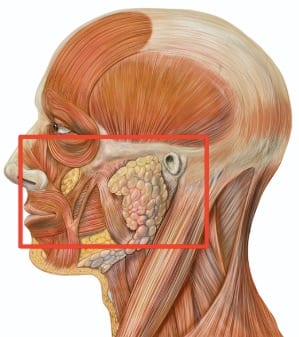
“The neural regulation of the face – the mouth, the oral area, the eyes, and even controlling muscles of the middle ear – are related to the vagal regulation of our heart.
So when we do these behaviors – when we sing or chant, we’re enhancing the regulation of the heart through this vagal pathway.”
– Dr. Stephen Porges
Chanting also stimulates the larynx nerves located in our throat.
These nerves are a branch of the Vagus nerve, and therefore activate that relaxation response and also activate the “brake” that slows down the stress response. (11)
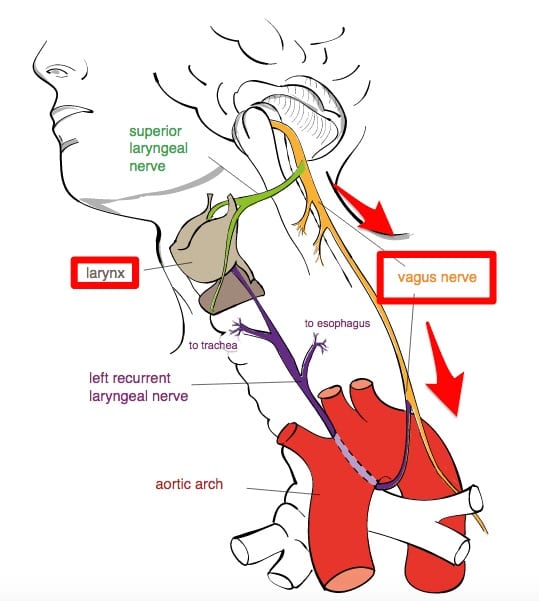
Want to take chanting meditation to the next level?
Pair it with pranayama (yoga breathing) exercises that involve deep, intentional belly breaths.
Belly breathing is another way to stimulate the Vagus nerve by stimulating the diaphragm, the dome-shaped muscle that sits atop your digestive organs and below your lungs.
3 Famous Meditators Who Used The Power of Chanting To Realize Their Potential:
1- Tina Turner

The artist found solace and meaning by chanting the Buddhist mantras: Nam Myoho Renge Kyo and Om Mani Padme Hum.
She credits her Buddhist faith and chanting practice for saving her during her darkest moments after she tried to commit suicide during her highly abusive marriage with then-husband, Ike Turner.
In a Larry King Live interview, when asked about chanting, she said:
“The practice in the early stages of it, when it was introduced to me was that it could change your life if that’s what you were looking for.
And at that time, that was definitely what I wanted…
And I had to teach myself because I didn’t have the freedom to actually go to meetings or for people to come to me.
So I remember working really hard, and I remember that I did it that way because it was on my own that I really struggled for it.
It changed my life.” (12)
2- Russell Simmons

This music media mogul and serial entrepreneur first discovered yoga in 1994 when he was dragged to his first class.
He said:
“I was high after that class.
I was present for a moment, and for that moment, I didn’t feel anxiety.
I used to think anxiety was a driving force in my career.
The idea that I would stay up all night worrying, I used to think that was a part of what made me successful.
And obviously, nothing is further from the truth,” (13)
Meditative practices like mantra chanting soon followed, and today yoga and meditation are a part of his everyday life.
Simmons clearly honors the power of vibration healing through chanting.
His app Meditation Made Simple offers a ‘vibration’ option for the mantra chant “rum.”:
“Whatever associations you have with the word “rum,” let them go.
In fact, try to stop thinking of it as a word at all.
Instead, just think of it as a vibration.
Remember, words are static. Vibrations are free.” (14)
3- Steve Jobs

It’s well known that the infamous Apple founder was a true “seeker” who kept a copy of Paramahansa Yogananda’s “Autobiography of a Yogi” always nearby.
His study of Zen Buddhism transformed him into a serious practitioner who opted for long, intense meditation retreats at the first Zen monastery in the United States, which included a meditative chanting practice. (15)
REFERENCES
:
(1) https://en.wikipedia.org/wiki/Functional_magnetic_resonance_imaging
(2) https://www.ncbi.nlm.nih.gov/pmc/articles/PMC3099099/
(3) https://www.ncbi.nlm.nih.gov/pubmed/30099280
(4) https://www.ncbi.nlm.nih.gov/pmc/articles/PMC6388631/
(5) https://www.ncbi.nlm.nih.gov/pubmed/22268968
(6) https://www.nature.com/articles/s41598-019-40200-w.pdf
(7) https://www.researchgate.net/publication/281179726_Deactivation_of_the_medial_prefrontal_cortex_in_experienced_Zen_meditators_Abstract
(8) https://www.frontiersin.org/articles/10.3389/fnint.2013.00083/full
(9) https://www.ncbi.nlm.nih.gov/pubmed/22020231
(10) https://www.ncbi.nlm.nih.gov/pubmed/6165548
(11) https://www.youtube.com/watch?v=VAL-MMYptQc
(12) https://www.youtube.com/watch?v=MOsr_ZOi-Jo
(13) https://www.nytimes.com/2016/11/17/fashion/russell-simmons-yoga-los-angeles-tantris.html
(14) Simmons, Russell; Morrow, Chris. Success Through Stillness: Meditation Made Simple, 2014
(15) http://blogs.plos.org/neurotribes/2015/10/26/what-kind-of-buddhist-was-steve-jobs-really/


